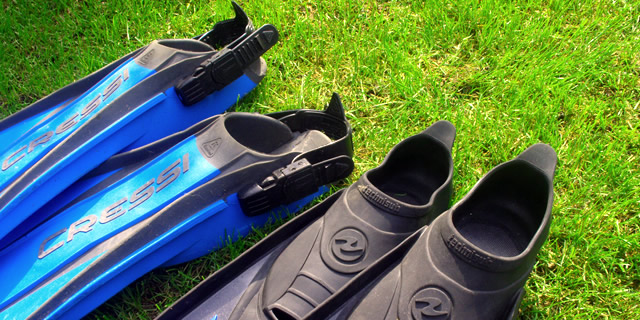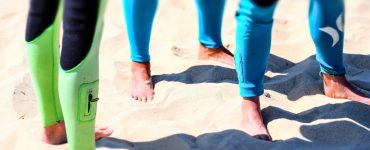For most divers, a pair of fins and a mask are their first purchase after becoming certified divers.
Most fins are made from rubber, plastic, or some combination of these materials, and are also known as swimming fins or flippers. (your dive instructor probably told you never to call them flippers though).
Fins are designed to improve the shape of human feet underwater. They provide a means for humans to propel themselves forward with less effort. Swimming fins mimic a fish fin, using the increased surface area to give increased propulsion. There are many different kinds of fins, all of which are suited to different types of use.
For example; free divers use very long fins which are designed to reduce energy expenditure, and in turn helps to conserve air.
Choosing the right fins
Fins are one of the most important tools for a diver, so it’s essential to get a pair that is right. You may find that needs change as fitness and experience increases, but make sure you are always diving with equipment that feels comfortable.
When specifically designed for scuba diving, fins are generally long, which offers us better propulsion with minimal effort. Some fins have channels or
Fins reduce fatigue and chance of cramp, so you can dive for longer, and enjoy it more. Make sure your fins are always fastened securely and not pinching or restricting your feet before entering the water. You depend on your fins for speed and movement, so ensuring they are fitted correctly is extremely important.
When choosing the right fin, always remember that with an efficient fin there will be an immediate connection between how much oxygen and energy your body uses and thus how much air you consume. This is especially important for novice scuba divers who will undoubtedly need to save air more than an advanced diver.
There is a vast array of fins on the market and you will need to consider your level of experience, kicking style, leg power and type of diving you will be doing in order to determine which type will best suit you. Diving fins should neither be too short or too long.
A Personal choice
When selecting a fin just remember, the stronger the leg, the longer and stiffer the fin should be. However, fins with rigid sides and a flexible middle made up of different materials will generally provide more thrust power with less effort.
Many top end fins will incorporate a number of materials in the blade and foot pocket. These materials can include carbon fiber, graphite, and polymers to maximize the amount of energy transfer from the leg to the fin. Believe it or not, there is a great deal of science that has gone into the manufacture of fins!
Full-Foots vs. Open-Heels
Sometimes fins can also be worn over diving boots, which will help you keep warm if you’re diving in deep or colder waters. These open-heel fins have adjustable straps which will allow for different boot sizes.

Wearing boots offers your feet more protection as well as giving you added warmth. On the other hand, full-foot fins, like the name suggests, cover your entire foot. Full-foot fins cannot be worn with diving boots and are generally your best option in warmer waters.
Full-foot fins are significantly lighter than open-heel fins and create less drag since they are more ‘aerodynamic’. They also have a tendency to have more flexible and shorter blades, making them easier to kick with. Since full-foot fins are intended to slip over your barefoot, you don’t need to wear a dive boot either. This helps the rubber foot pocket to grip the foot very firmly and allows for a more productive exchange of energy from foot to fin.
Getting an ideal fit in a full-foot fin before purchase is critical to efficiency and comfort because the foot pocket can’t be adjusted. Too large, and it will slip off your foot while diving. Too small and the foot pocket will hurt your toes and foot after a while.














